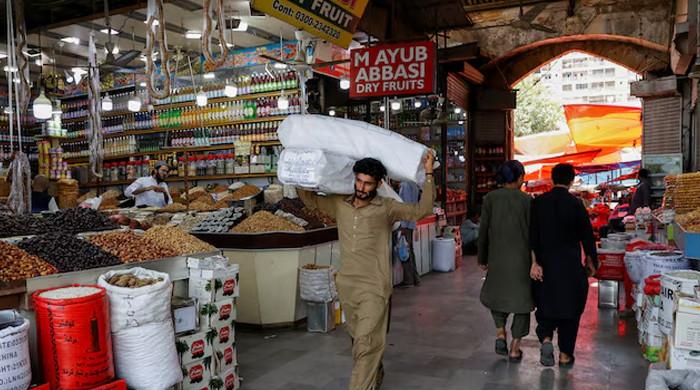- The UN World Economic Situation and View of 2025 -Report Released.
- The United Nations report says Pakistan should see moderate growth.
- The outlook in the short term for South Asia is expected to remain robust.
The United Nations: Pakistan, an important part of the South Asian region, is expected to experience “moderate growth, stabilization after a period of economic contraction”, with its gross domestic product (GDP), which is expected to expand by 2.3% in 2025, according to a UN report.
The report entitled ‘The UN World Economic Situation and Udsights 2025’ noted that falling inflation has made it possible for most of the South Asian region’s central banks to begin or continue monetary relief in 2025.
Meanwhile, governments in Pakistan, Bangladesh and Sri Lanka are expected to continue fiscal consolidation and economic reforms during the International Monetary Fund (IMF) -supported programs.
It said the prospects of South Asia are expected to remain robust, with growth projected to 5.7% in 2025 and 6.0% in 2026, “driven by strong performance in India as well as economic recovery in a few other economies”, including Bhutan, Nepal and Sri Lanka.
The report said the global economy is at an uncertain time, characterized by increased merchant stresses and increased police uncertainty. The recent increase in tariffs – which drives up the effective US duty rate steeply – threatens to raise production costs, interfere with global supply chains and reinforce economic turbulence.
Uncertainty about trade and economic policies combined with a fleeting geopolitical landscape asks companies to delay or scale down critical investment decisions. This development exacerbates existing challenges, including high debt levels and sluggish productivity growth, which further undermines global growth opportunities.
Global GDP growth is now expected only 2.4% in 2025, down from 2.9% in 2024 and 0.4 percentage points during the projection in January 2025.
Slower global growth, increased inflation pressure and weakening of global trade – including an expected halving of trade growth from 3.3% by 2024 to 1.6% in 2025 – brings progress towards the goals of sustainable development.
The slowdown is broad -based, which affects both developed and developing economies. Growth in the United States is expected to decelerate significantly, from 2.8% by 2024 to 1.6% in 2025, with higher duties and political uncertainty expected to weigh for private investment and consumption. In the European Union, GDP growth is expected of 1.0% in 2025, unchanged from 2024, in the midst of weaker net exports and higher trade barriers.
China’s growth is expected to slowly to 4.6% this year, reflecting muted consumer mood, disruptions in export -oriented production and ongoing challenges for the real estate sector. Several other major development economies, including Brazil, Mexico and South Africa, are also facing growth downgrades due to the weakening of trade, slowdown for investment and falling commodity prices. India, whose growth forecast from 2025 has been revised downwards to 6.3%, is still one of the fastest growing large economies.
“The tariff chocro is affecting vulnerable developing countries Hard, slow growth, cutting-out export revenue and composite debt challenges, especially as these economies are already struggling to make the investments needed for long-term, sustainable development,” said the United Nations Under Secretary General of Economic and Social Affairs Li Junhua.
While global headline inflation relieved 5.7% by 2023 to 4.0% in 2024, the price remains stubbornly in many economies. At the beginning of 2025, inflation exceeded before-pandemic average in two-thirds of the countries, with over 20 developing economies facing double-digit rates.
Food inflation, on average over 6%, continues to hit households with low income hardest, especially in Africa, South Asia and West Asia. Higher trade barriers and Klimachok further amplify inflation risks, which emphasizes the need for coordinated policies-there combines credible monetary framework, targeted fiscal support and long-term strategies to stabilize prices and protect the most vulnerable.
In many countries, monetary policy challenges have intensified in an uncertain economic environment. Central banks are struggling with difficult trade-off between the control of inflation pressure-derived by customs-induced price shock and supports slow economies. At the same time, limited fiscal space limits, especially in development economies, governments’ ability to effectively mitigate the economic slowdown.
Aggravation of global prospects and geopolitical fragmentation undermines the development of development.
For many developing countries, this bleak economic prospects understood prospects of creating jobs, reducing poverty and tackling inequality. For least developed countries – where growth is expected to slow down from 4.5% by 2024 to 4.1% in 2025 – declining export revenue, tight economic conditions and reduced official development assistance threatening to further erode fiscal space and increase the risk of debt difficulties.
Escaling of the trade frictions further spans the multilateral trading system, leaving small and vulnerable economies increasingly marginalized in a fragmented global landscape.
Strengthening multilateral cooperation is important for tackling these challenges. Revitalizing the rules -based trading system and providing targeted support to vulnerable countries will be critical for promoting sustainable and inclusive development.
The fourth international conference on funding for development taking place in Sevilla, Spain, from June 30 to July 3, 2025, will be a crucial platform to tackle issues such as strengthening multilateral cooperation, debt sustainability and more to drive concrete actions on financing for sustainable development for all, added the report.



